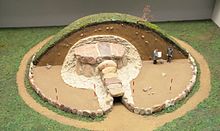Over Jersdal megalithic sites
The megalithic complexes of Over Jersdal (also Over Jerstal) are located southwest of Haderslev and south of the Jutland town of Vojens and north of Over Jersdal in Denmark . It is about two passage graves and two dolmens , which as megalithic systems of the funnel cup culture (TBK) between 3500 and 2800 BC. BC originated. Neolithic monuments are an expression of the culture and ideology of Neolithic societies. Their origin and function are considered to be the hallmarks of social development.
The two passage graves are located in round hills and were examined in 1931.
Passage grave 1
The approximately three meter high round hill has a diameter of 17 m. The corridor, the stones of which are almost completely missing, starts in the east and is eight meters long. The north-south oriented slightly trapezoidal chamber is three meters long, 1.5 by 1.4 m wide and 1.6 m high. It is made up of wide intermediate masonry and six bearing stones and one oversized cap stone, which is 1.1 m thick. All stones are in situ . 55 ° 12 '36.5 " N , 9 ° 17" 54.9 " E
Passage grave 2
The 1.75–2.2 m high, flattened uneven hill is roughly oval and 17–18 m in diameter. The corridor starts in the east, is 5.60 m long and at the entrance to the chamber 0.5 m wide and 1.1 m high. The north-east-south-west oriented chamber of double trapezoid shape is 1.6 m high, about four meters long, 2.25 m wide in the middle and narrower at the ends. It is made up of nine bearing stones and two cap stones that are in situ . Location: 55 ° 12 ′ 34.5 ″ N , 9 ° 17 ′ 55.6 ″ E
Runddysse 1
The Runddysse is largely destroyed. In the remainder of the hill, about one meter high, there is a one meter deep and about 2.5 m long pit in which the remaining bearing stones or their remains lie. Location: 55 ° 12 ′ 34.6 ″ N , 9 ° 17 ′ 56.5 ″ E
Runddysse 2
In a field are overgrown and covered with rubbish, the remains of a small chamber from which three stones are visible. The north-south oriented chamber is 1.7 m long, 0.9 m wide and 0.60 m high in the lower area. 55.174210N Longitude: 9.291423ELosition: 55 ° 10 ′ 27.2 ″ N , 9 ° 17 ′ 29.1 ″ E
- In the north there is a 0.95 m wide, 0.40 m thick and 0.70 m high stone in a small slant.
- In the east there is a 1.45 m wide, 0.60 m high and thick stone.
- In the west a stone 1.45 m wide, 0.40 m thick, 0.70 m high.
- To the south, where the entrance is, a stone that is 1.30 m wide and 0.80 m high and covered with earth.
The chamber. which is missing the capstone and the intermediate masonry has been excavated, no finds have been made. About four meters south of the chamber is a 0.9 m long stone, which was probably a curb.
See also
literature
- Karsten Kjer Michaelsen: Politikens bog om Danmarks oldtid (= Politikens håndbøger. ). Politiken, Copenhagen 2002, ISBN 87-567-6458-8 .
Individual evidence
- ^ Johannes Müller : Neolithic Monuments and Neolithic Societies. In: Hans-Jürgen Beier , Erich Claßen, Thomas Doppler, Britta Ramminger (eds.): Varia neolithica VI. Neolithic Monuments and Neolithic Societies. Contributions from the meeting of the Neolithic Working Group during the annual meeting of the North-West German Association for Ancient Research in Schleswig, 9. – 10. October 2007 (= contributions to the prehistory and early history of Central Europe. Vol. 56). Beier & Beran, Langenweißbach 2009, ISBN 978-3-941171-28-2 , pp. 7-16, here p. 15.
- ↑ Runddysser is the name commonly used in Denmark for dolmens that are located in a round hill. In contrast to this, Langdolmen or Langdysser are those dolmens that lie in a rectangular or trapezoidal barn bed



